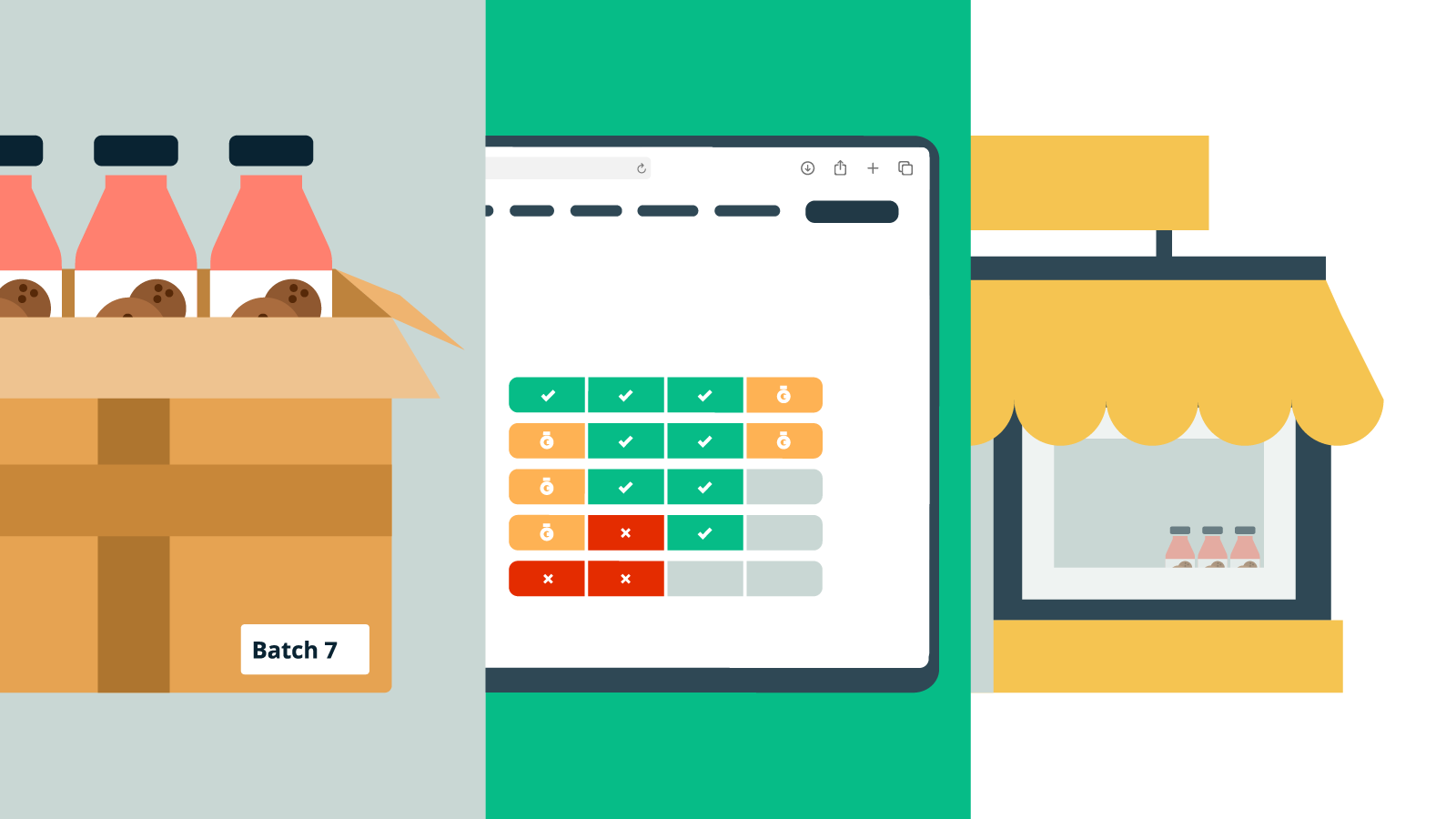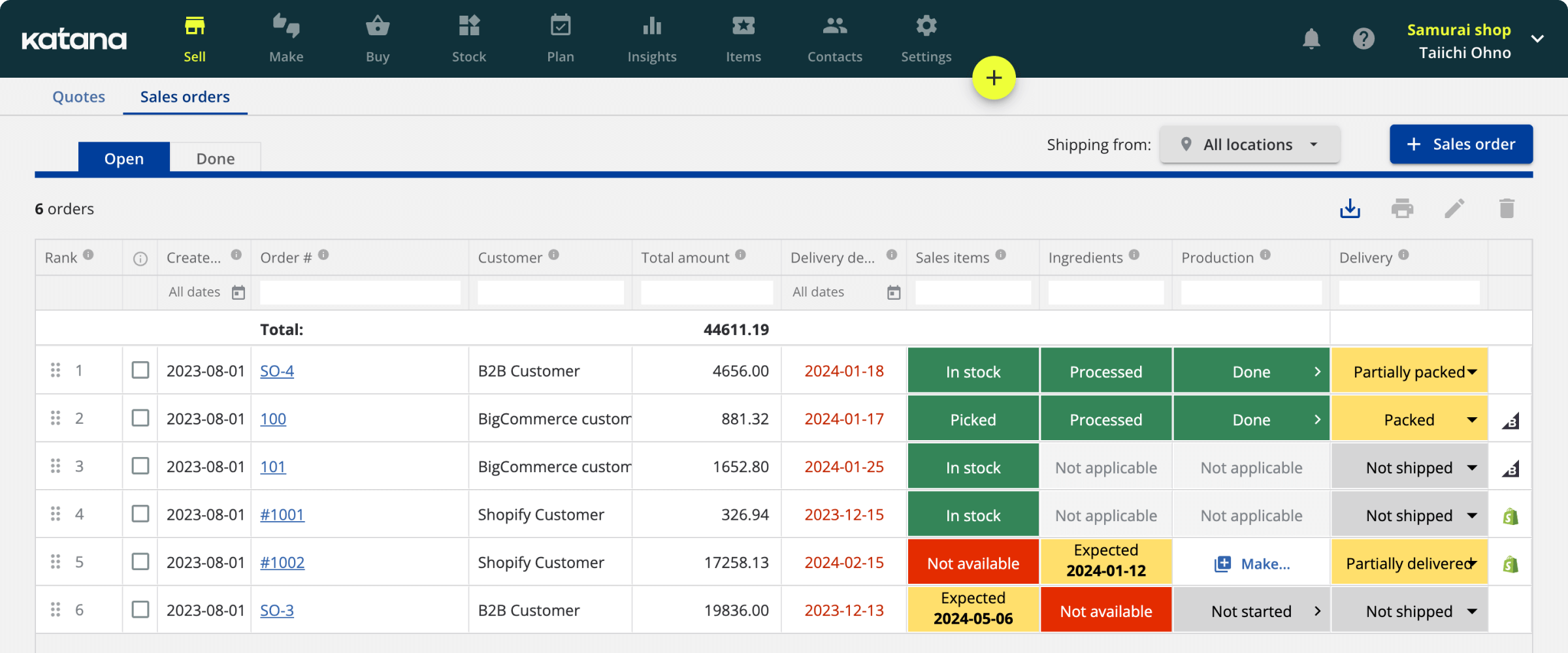Mastering multichannel inventory management
In the busy world of modern commerce, businesses often find themselves juggling a multitude of sales channels and inventory data. Learn to transform this multichannel complexity into a symphony of success with multichannel inventory management.

Henry Kivimaa

Whether you’re a classical music enthusiast or not, you can’t deny the important role of the conductor. As challenging as it is combining various instruments into a harmonious melody, so is managing a wide range of ecommerce channels.
In the evolving world of commerce, businesses are constantly exploring new ways to expand their reach and tap into diverse customer segments. One approach that has gained a significant following in recent years is multichannel retailing.
Think of your ecommerce channels as different instruments and multichannel inventory management software as the conductor skillfully combining the notes into a beautiful harmony. Combine your expertise with advanced technology and orchestrate a seamless sales symphony.
What is multichannel inventory management?

Multichannel inventory management is a strategic approach for efficiently controlling, tracking, and optimizing a company’s stock across all its sales channels and locations. As businesses expand across multiple sales channels, the need for efficient ecommerce inventory management software becomes critical.
Multichannel inventory management allows businesses to sync their inventory and monitor their goods across all touchpoints. This provides a seamless shopping experience for customers and smoother inventory processes for the vendor.
A multichannel approach also lets businesses reach a wider audience and optimize their operations, ultimately leading to improved sales and growth. Overall it contributes to enhancing the customer experience, optimizing inventory operations, and streamlining order fulfillment processes.
Download the ultimate guide to inventory management
A comprehensive ebook with everything you need to know about inventory management.
Multichannel sales platforms

Multichannel sales help businesses expand their reach and reach their target market. It encompasses various channels, both online and offline.
Ecommerce platforms
Ecommerce platforms like Shopify and WooCommerce give businesses the means to create an online presence and allow customers to purchase products directly from a company’s website.
Multichannel ecommerce inventory management is a systemic way to handle the challenges of online retail while simultaneously preventing overselling. For those using dropshipping, coordinating stock levels with suppliers is crucial and often requires automated systems.
Ecommerce retailers often sell product bundles or kits, so inventory management must easily handle these tricky product structures.
Managing returns is another critical aspect that needs to ensure that stock levels are updated accurately after processing returns.
Ecommerce often faces demand fluctuations based on seasons or trends. This creates a need for flexible inventory management solutions. For businesses dealing with perishables or time-sensitive products like food, coffee, or cosmetics, expiry date and batch tracking help avoid selling outdated items.
Shopify Ecommerce Report 2024
In our latest report, we gathered data from 100 SMB Shopify merchants to understand their key challenges and how inventory software and AI can help overcome them.
Online marketplaces
Marketplaces like Amazon, eBay, and Etsy are popular websites that allow businesses to reach a larger customer base by giving companies a platform to list and sell their products alongside other sellers.
This solution often involves high sales volumes, making real-time inventory updates critical to avoid overselling. Marketplace sellers may also offer products from various suppliers, which requires efficiently managing multiple sources of stock.
The challenges in online marketplaces are similar to those of ecommerce platforms, as they’re often the go-to solution for businesses without their own web stores.
Physical stores
Brick-and-mortar stores are more traditional sales channels where customers can go to see, touch, try, and buy goods. Here, maintaining optimal stock levels is essential to meet demand and maximize profits.
Store managers need to balance avoiding stockouts, which can result in lost sales and disappointed customers, and overstocking, which ties up capital and storage space.
Theft and inventory shrinkage are constant concerns that require specific security and prevention methods.
Many physical stores still rely on manual tracking, making it difficult to keep accurate and up-to-date inventory records, especially in larger retail operations or franchises.
Social media
Social media platforms like Facebook, Instagram, and Pinterest allow businesses to sell products directly through posts and advertisements. Social media can also be used to communicate with customers, helping businesses stay connected to buyers and promptly answer questions about product availability and delivery times.
Tracking feedback on social platforms can offer valuable insights into demand and buyer preferences, allowing businesses to make better purchasing and stocking decisions.
However, social media also presents challenges, such as managing customer expectations in real time and handling inventory discrepancies between online listings and in-store availability.
Mobile apps
More and more businesses are using mobile apps to offer customers a convenient shopping experience. Mobile commerce, or m-commerce, has become popular in recent years due to the rise of smart devices.
Inventory management for mobile apps is all about keeping product listings up to date and synced with your physical stock and other sales channels. Mobile apps provide opportunities for targeted promotions and push notifications to boost sales and clear out any excess inventory.
Maintaining a seamless user experience and smooth order fulfillment is crucial. Potential app crashes and bugs can disrupt operations, potentially losing sales and customers, so these issues must be addressed promptly and communicated to customers.
Amazon’s pandemic triumph
Before Covid-19, many businesses operated only from brick-and-mortar stores, allowing buyers to get the full shopping experience in a physical location.
With lockdowns happening and stores being forced to close, sellers had to find new ways to keep buyers engaged and products moving. Thus, the online shopping boom ensued, with a whopping 43% increase in ecommerce sales in 2020.
Although the chaos of the pandemic is now a mere memory, ecommerce continues to accelerate amongst both shoppers and vendors.
Amazon, the largest ecommerce channel in the world, reported a profit rise of nearly 200% in 2020-2021, with a big part of this thanks to online sales. However, another aspect of Amazon’s success comes from the sudden popularity of Amazon Web Services (AWS) — a cloud platform for businesses to store and centralize their data.
With the creation and scaling of online stores, many companies adopted AWS to manage their website data effectively and reliably. This further solidified the ecommerce titan’s position as number one while also setting the stage for starting online businesses to enter the market.
This is only one example of how businesses that improvise, adapt, and overcome can become industry leaders.
The basics of multichannel inventory management

It’s important to be aware of the essential components that make up the foundation of a synchronized operation. This helps you keep an eye on each element and make sure every aspect of your inventory is covered efficiently.
Managing inventory across multiple locations can be complex, but a smart strategy and the right tools can make your life a whole lot easier. Whether you run several brick-and-mortar stores, use third-party logistics providers, or have warehouses in different regions — the end goal is to ensure that inventory is in the right place at the right time and always available when needed.
Inventory centralization
Inventory centralization involves gathering all your inventory data and resources into one unified system or location.
It offers complete visibility and control over inventory, providing real-time insights into stock levels and demand fluctuations. This allows businesses to develop better strategies for restocking and order fulfillment, ultimately reducing the risk of stockouts and overstocking.
Centralization also leads to significant cost savings by optimizing stock levels, reducing carrying costs, and preventing inventory duplication. Plus, it streamlines the supply chain and boosts operational efficiency.
Centralized inventory management makes compliance and reporting a breeze as all data is easily accessible. In a fast-paced business environment, inventory centralization is key to maintaining a competitive edge and ensuring lean, cost-effective inventory management.
Real-time updates
Real-time updates in inventory management refer to the live tracking of inventory levels and changes, so you always have up-to-date info. This means that any stock addition or deduction, whether due to sales, new purchases, or returns, is immediately shown in the inventory system.
Real-time updates are a real game-changer in inventory management, giving businesses accurate information about stock levels. This synchronized data means making better business decisions and responding quickly to shifts in demand or supply chain disruptions. It minimizes the risk of stockouts by automatically triggering reorder points and alerts when inventory numbers drop below set levels.
Also, real-time updates promote transparency within the organization by giving everyone access to the same inventory data, ensuring seamless collaboration, and creating more efficient workflows across the entire company.
Inventory forecasting
Inventory forecasting is a critical component of multichannel inventory management.
It’s all about predicting demand and optimizing stock levels across all sales channels. Use inventory forecasting tools to determine how much stock each location should hold. This prevents overstocking in one place and stockouts in another.
Companies can make informed decisions about their stocking practices by:
- Analyzing historical sales data
- Anticipating seasonality
- Monitoring trends
- Assessing market conditions
Accurate forecasting means saying goodbye to the headaches of overstocking and understocking, large storage costs, and lost sales. To streamline this process, find a multichannel inventory management system with forecasting capabilities.
Inventory forecasting with Katana
Katana offers inventory forecasting features for businesses wishing to predict future trends, set accurate reorder points, and find the perfect balance between understocking and excess inventory.
Take a short product tour of the platform below and book a demo to learn more from our experts.
Order routing
Order routing is essential for efficient inventory management and fulfillment processes. It consists of finding the optimal path for customer orders, from the moment of they’re placed to when their arrive at their destination. The ultimate goal is to minimize lead times and keep costs down while making sure customers are happy with their purchases and the service they receive.
An order routing system includes several factors, such as:
- Availability of products in different warehouse locations
- Proximity of these warehouses to the buyer’s delivery address
- Chosen shipping method
The system ensures that orders are directed to the warehouse that can fulfill them most effectively. Sometimes, this may mean splitting one order into multiple shipments for a faster and cheaper delivery.
Effective order routing can have a hugely positive impact on customer experience. It ensures on-time deliveries and avoids having to cancel orders that can’t be fulfilled. It also helps reduce expenses by optimizing shipping costs and avoiding unnecessary inventory movements.
In essence, order routing smoothens the path from order to delivery, enhancing customer satisfaction and operational efficiency.
Safety stock
Safety stock is essentially a buffer for businesses to mitigate the risk of stockouts or order delays. It’s like an insurance policy, protecting you against unexpected changes in demand or supply chain hiccups.
By strategically managing safety stock levels, businesses can meet customer orders promptly, no matter what surprises pop up.
However, it’s important to strike a balance when determining the amount of safety stock to hold. Too much can tie up capital and increase storage costs, while too little can leave a business vulnerable to disruptions.
Data integration
Integrating multiple sales channels is a common practice in multichannel inventory management.
Integrations bring together data from different sales channels to manage inventory across all your platforms. This process makes it easy for organizations to collect, process, and analyze data from different systems, no matter the format.
Data integration is absolutely essential to achieve a comprehensive understanding of how a business and all its sales channels operate.
In today’s data-driven business landscape, data integration is essential for making smart decisions, creating reports, and doing in-depth analytics. It minimizes data isolation, provides up-to-date information, and facilitates creating better business strategies.
Challenges of multichannel inventory management

Implementing a multichannel inventory management strategy can present some challenges. However, once you have identified and addressed them, you can figure out and implement the best strategy.
- Data synchronization — It can be difficult to keep all sales channels consistent with up-to-date product information, stock levels, and pricing. Investing in smooth synchronization can make the shopping experience easier and more pleasant for your customers
- Overstocking and understocking — Dealing with inventory levels across multiple locations can be a real headache, resulting in overstocking in some places and understocking in others. Once you figure out the balance, you can optimize your costs, storage use, and effort put into inventory management
- Order routing complexity — Determining the most efficient location for order fulfillment can be complex, especially when considering factors like shipping costs, inventory availability, and order priorities. Failing to optimize order routing can lead to increased operational costs
- Inventory visibility — Maintaining real-time inventory visibility across various locations and sales channels can be challenging. Customers expect to know whether a product is in stock and where it’s available, and failing to provide this information can result in lost sales
- Technical integration — Integrating different sales channels, including ecommerce platforms, marketplaces, and physical stores, requires technical expertise. Compatibility issues between systems can lead to inefficiencies and data inaccuracies, potentially resulting in errors and discrepancies in your work
Benefits of multichannel inventory management

Despite its challenges, multichannel inventory management offers many benefits that can have a positive impact on the bottom line of your business and customer satisfaction.
- Enhanced customer experience — Providing customers with consistent product information, real-time stock availability, and convenient shopping options across multiple channels creates a seamless and satisfying experience. With transparent stock levels, your buyers can easily pick the perfect store for pickup or opt for online shopping if they have specific delivery needs
- Increased sales — Expanding your presence across various sales channels is a great way to boost sales, tap into new revenue streams, and reach a broader audience. This strategy allows you to scale your business, increase brand visibility, and get your products out to more people
- Inventory optimization — By managing your inventory across different channels, you can ensure you have just the right amount of stock to meet demand, saving you money and boosting profits
- Improved operational efficiency — Automation and streamlined processes in multichannel inventory management can really boost operational efficiency. With centralized control, you can cut down on manual errors, speed up order processing, and improve collaboration between teams and locations
- Better decision-making — Stay on top of your business with real-time data and reporting tools to make smart choices about inventory, pricing, and marketing strategies
10 tips for multichannel inventory management

Creating a successful multichannel inventory management strategy requires a comprehensive approach. These tips will help improve your retail operations across all your sales channels.
1. Choose the right software
Picking the right inventory management software is crucial. You’ll want to find a solution that integrates seamlessly with your ecommerce platforms, online marketplaces, and other sales channels. Make sure it offers live inventory updates, centralized control, and demand planning capabilities to streamline daily operations.
2. Optimize your listings
Ensure your product listings are accurate and up-to-date across all channels. Taking time to enhance your listings with catchy titles, detailed descriptions, and professional images can greatly boost visibility and sales.
3. Implement automation
Embrace automation wherever possible. Automated systems can help you sync stock levels with suppliers, process returns efficiently, and keep inventory levels updated in real time. With inventory management automation, you’ll minimize errors and have more time for more strategic tasks.
4. Monitor and adjust
Regularly monitor your inventory performance. Dive into sales data, check stock levels, and listen to customer feedback. Use this information to make smarter decisions about restocking, pricing, and marketing. Stay flexible and tweak your strategy to adjust to changing market conditions.
5. Training and collaboration
Multichannel inventory management requires everyone on the team to be aligned. Train your staff to make they know how to use the inventory management software to its full potential. Working together across different departments is crucial, as it helps streamline workflows and ensures that all teams are on the same page.
Simplify multichannel inventory management with Katana
Running multiple sales channels can be challenging. Katana can take some of the burden off you, streamlining your inventory management tasks and other essential business operations.
6. Security measures
Security is crucial in multichannel inventory management. Protect your data, especially when integrating various sales channels. Implement secure access controls, use encryption where necessary, and regularly update your software to guard against security threats.
7. Customer communication
Keep your customers in the loop at all times. Make sure they know about stock levels, delivery times, and any possible delays. Answer customer messages and questions quickly to build trust and make their experience seamless.
8. Expand gradually
If you’re new to multichannel inventory management, slow and steady is the way to go. Start off by adding a new channel or two and see how they work for you. As you gain more experience and confidence, you can easily add more channels to your portfolio.
9. Monitor competitors
Keep an eye on what your competitors are doing. See how they manage their inventory, build pricing strategies, and engage with customers. Learning from their successes and failures can help you pick some nifty tips and tricks for your own multichannel journey.
10. Regular audits
Perform regular audits of your inventory. Stocktakes ensure that the number of items on the shelves matches your recorded inventory levels, especially in physical stores. These audits help you spot any discrepancies early on, prevent inventory loss, and also point out areas for further improvement.
These tips allow businesses to successfully navigate the complex landscape of multichannel inventory management. All that’s missing now is a reliable software solution.
Multichannel inventory management with Katana

As businesses seek for ways to stay ahead in the multichannel retailing landscape, they turn to software solutions that can streamline their processes and make their lives easier overall. That’s where Katana comes in!
Katana’s cloud-based inventory management software is designed for small and medium-sized businesses. Whether you’re selling through online platforms, marketplaces, or brick-and-mortar stores, Katana has you covered.
Katana offers a wide range of features to streamline your inventory management, so you can focus on more important things — like growing your business.
- Real-time inventory management — With Katana, you’ll always be up to date on your stock levels and sales across all your channels. This provides you with the data to make informed decisions, avoid running out of stock, and manage all your carrying costs easily
- Order management — Katana streamlines your order fulfillment by routing orders to the most appropriate location, considering factors like inventory availability and shipping costs. This can not only significantly lower shipping costs but also increase customer satisfaction
- Centralized multichannel control — Katana centralizes your inventory data, making it accessible and consistent across various sales channels. Say goodbye to data discrepancies and miscommunications between teams
- Inventory forecasting — The software provides forecasting tools to help you predict demand and make better stocking decisions. Avoid understocking and excess inventory with the help of past data and future trends
Katana also offers other beneficial features to build your business up beyond multichannel inventory management.
Integrations
Choose from a wide range of built-in integrations, or take advantage of Katana’s open API and create custom workflows using the software you already use and love. From ecommerce to shipping, accounting to CRM — there’s something for every aspect of your business and plenty more ways to build your own workspace. Check out all the built-in integrations here.
End-to-end traceability
Track your materials and products across the whole supply chain to keep tabs on shipments and goods received and sent out. When you work with perishable goods, there are many industry standards to meet, and tracking expiry dates across batches simplifies complying with all the rules. Whether you wish to mark your products with serial codes or barcodes, traceability software can help you label, identify, and track your goods from creation to delivery to customer, making quality assurance and recalls much easier.
Manufacturing
If you not only sell but also produce your own goods, try out Katana’s manufacturing features, including:
Don’t worry about having to handle separate software for your inventory management and manufacturing — Katana can do both and more.
To find out more about Katana’s capabilities and benefits, take an interactive tour of the platform.
Conclusion
Multichannel inventory management is an essential aspect of modern retail and commerce. It involves providing customers with a seamless shopping experience across different sales platforms.
While it definitely has its challenges, the perks of multichannel inventory management are impressive and can lead to increased sales, happier customers, and smoother operations.
With its robust features and user-friendly interface, Katana is a valuable tool for businesses looking to master multichannel inventory management. Real-time inventory tracking, order routing capabilities, and integrations with popular sales channels make it a great solution for small and medium-sized enterprises.
Want to learn more about Katana? Book a demo with our team of experts and get all your questions answered.

Henry Kivimaa
Table of contents
Get inventory trends, news, and tips every month
Get visibility over your sales and stock
Wave goodbye to uncertainty by using Katana Cloud Inventory for total inventory control
